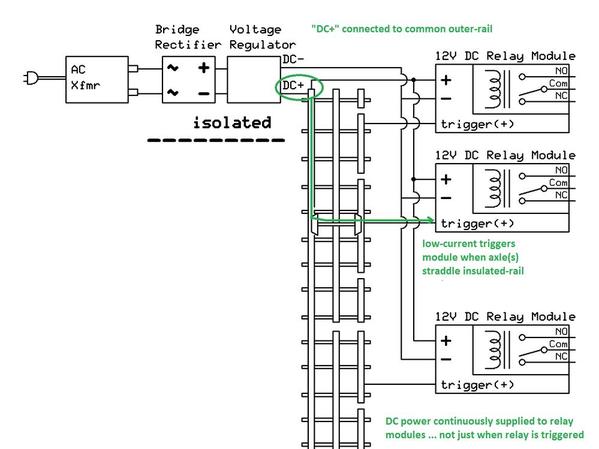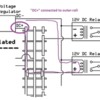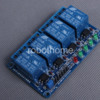I think it is something about the transfer of metal from one contact surface to the other
LOL. Nothing so sinister!
But first to close out what Ken asked in his initial post:

The "new" AC transformer that will be supplying DC power for the DC relays does NOT need to be "phased" with the existing AC transformers that power the tracks. However, as stated earlier, its output must be isolated from the existing AC transformer outputs. Obviously the inputs to all the transformers, new and old are not isolated from each other as they all plug into inter-connected 120V AC power strips, wall-outlets, etc.. The 2 wire outputs of the "new" AC transfomer can be connected without regard to "phase" into the squiggly-line "~" inputs of the bridge as illustrated above.
The output of the bridge apparently goes into a home-built DC voltage regulator/power supply. Or this could be a 99 cent eBay DC-to-DC voltage regulator module. Let's just say we're running 12V DC since 12V relays are probably the most common type out there for the hobbyist. As shown, the typical approach is to connect DC- to the outer rail. Then DC+ is connected to one side of each relay coil. When an axle straddles an insulated-section, it supplies DC- from the common outer-rail to the other side of the corresponding relay and you're off to the races. The orange line shows the current path to activate the relay coil; note that the full-current of the relay coil flows across the axle(s) and thru the common outer-rail...this might be, say, 50 mA for a typical 12V DC relay. 50 mA is trivial relative to Amps of current flowing in the outer rail to drive trains, but this is just a statement of fact without prejudice.
OK. Onward to the "curious" stuff...

Because the DC supply is isolated from the AC train power, it doesn't matter which side of the DC (+ or -) is placed on the common outer-rail. So as shown above DC+ (instead of DC-) can be placed on the outer-rail. In this case one side of each relay coil would be connected to DC-. And when an axle(s) straddles an insulated section, DC+ is now presented to the corresponding relay and it's off to the races. The purple line shows the current path which is identical to the previous orange path; the direction (flow of electrons) is reversed but the path is the same. Again, the full current of the relay coil flows across the axle(s) and thru the outer rail.
So either way the relays behave the same, the cost of parts is the same, the amount of wiring is the same, etc. So when would a DC+ common make sense? Answer: when using an eBay 12V DC relay module that provides additional functionality. These relay modules have an on-board DC relay but additionally have circuitry (typically a microprocessor or timing components). As such they have 3 wires going into them (plus the same relay contacts on the output side). 2 wires supply continuous power to the module such as 12V DC. The 3rd new wire is the trigger input which activates the relay but with benefits. For example it can hold the relay closed for some adjustable/settable time delay (seconds, minutes) after the train leaves the insulated-section. Even with a minimal delay setting of less than 1 sec, it can demote flickering of the relay-controlled devices such as a signal light. The point is these "trigger" signals are often require DC+ or a so-called "high-level" trigger. This means you need to present DC+ to activate the module and hence DC+ needs to be on the common outer-rail!
 Some of these 12V relay modules can have impressive features such as so-called FRM01 module which has been discussed in several OGR threads. For less than $10 (free shipping from Asia), this module can, for example, turn on an accessory for 30 seconds, turn off for 10 seconds, and repeat this 17 (or 58, or however many) times all from a single trigger. Yes, this is a ridiculous example but I can't remember the exact applications from before.
Some of these 12V relay modules can have impressive features such as so-called FRM01 module which has been discussed in several OGR threads. For less than $10 (free shipping from Asia), this module can, for example, turn on an accessory for 30 seconds, turn off for 10 seconds, and repeat this 17 (or 58, or however many) times all from a single trigger. Yes, this is a ridiculous example but I can't remember the exact applications from before.

Or there are insanely (low) priced multi-channel 12V DC relay modules (less than $1 per relay on eBay, free shipping from Asia) that require a positive or high-level trigger to turn on the selected relay. Again, you'd supply the module with 12V DC power and then trigger the selected relay with a positive or high-level (DC+) trigger. Here's a typical 4-channel version:

Separately, an observation about using relay modules rather than "bare" relays. As mentioned earlier, if you use a bare relay, the full relay coil current flows across the axle(s) when triggering the relay. A relay module of the eBay ilk will generally have circuitry that requires a fraction of the coil current to trigger the relay; the module is continuously powered so has amplifier circuitry so the trigger input does not havbe to supply the full relay coil current. For eBay modules the trigger current is typically just a few mA rather than the 50 mA (or so) for a typical bare relay. In my opinion it's always a good idea to reduce switched control currents when possible.














